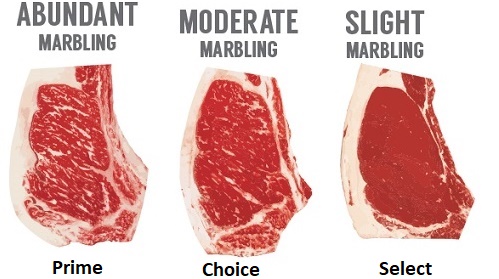
Tips and tricks to the perfect steak
By Paul Sidoriak
When you go to a restaurant, few things on the menu cost more than a deliciously juicy steak. For that reason, a trip to the steakhouse is often thought of as something saved for only the most special of occasions. But did you know you can often get better-than-steakhouse results at home by using the Blackstone Griddle?
Mastering cooking a perfect steak at home may take a bit of practice but here are some of the most helpful tips for getting you a bit closer to making the perfect steak on a griddle.
Meat selection is important
When shopping for a steak, it’s important to know a bit about different cuts of meat and how meat is graded.
There are 8 grades of beef, but the most commonly available ones fall into three categories:

Prime: This is the highest quality of beef. Only about 3% of beef can be called prime so you pay a premium for prime meat. Prime meat has a visible amount of intermuscular fat that transforms into a deliciously flavorful treat when cooked.
Choice: Over 50% of the beef sold at supermarkets is choice beef. It has less marbling than prime but is typically of excellent quality and flavorful.
Select: The lowest quality of meat sold at grocery stores, select meat is often quite lean which can mean far less juicy. Select meat is often on sale and the most affordable.
Seasoning is Always in Season
Some people think that the seasoning is what makes a steak. But the reality is that you want to be blown away by the delicious beefy flavor of the meat, not the razzle dazzle of a popular seasoning mix.
Salt Makes Steaks Sing with Flavor
The single best seasoning for steak is something most of us already have on hand. Salt.
There’s plenty of science behind the benefits of salting steaks before cooking but for now you’ll have to take my word for it.
Season your meat with about a half a tablespoon of salt per side. Allow the salt to do its magic for anywhere between a half hour and 6 hours before you cook.
The salted meat can sit on a plate uncovered in the refrigerator. Table salt works for this method, but it’s not optimal. Instead choose a pink Himalayan salt, sea salt, or kosher salt for best results.
Aside from the scientific benefits of salting or dry-brining your steak before cooking, there’s a distinct benefit of using salt as your primary seasoning on steaks. Salt doesn’t burn! You just can’t say that for the ingredients of popular steak seasonings.
Give Your Steak a Head Start
Most refrigerators keep meat at about 40F. We are looking to add about 100 degrees of temperature to the steak to achieve our desired doneness so allowing your meat to rest at room temperature before cooking gives it a bit of a head start.
Consider allowing your meat rest on a plate at room temperature (70-75F) for about 45 minutes before cooking. This will get the chill off of the meat slightly and allow the browning process or Maillard reaction to happen more quickly when the meat hits the griddle.
Dry, Dry Again
One of the benefits of cooking a steak on the Blackstone griddle is that you can achieve a beautiful brown crust that looks and tastes delicious.
The key to getting a beautifully browned steak is to make sure the steak is extremely dry before cooking.
Use two layers of paper towels doubled over to dry both the top and bottom of the steak. Allow the steaks to dry wrapped in the towels for about 2 minutes on a plate just before cooking. Flip and repeat to make sure both sides are well blotted.
Trim to Win
Unless you love the taste of beef fat, there’s no need to keep all the fat on the perimeter of a steak. Use a sharp knife to trim the fat down to about ¼” or remove it altogether from the meat. If you do prefer to keep some fat on the side of your steak, an easy trick to rendering it a bit is to place it against the side, or vertical wall of the Blackstone during cooking. You probably won’t render all of the fat but what does render will add a pop of flavor.
Take the guesswork out of when the steak is done
Using a thermometer is the only way to determine if a steak is cooked to your desired doneness. No amount of poking or prodding will give you a true understanding of how done a steak is, but an instant read thermometer will take away all the guessing.
Take temperature readings in a few different areas of the meat as close to the middle as possible for best results.


